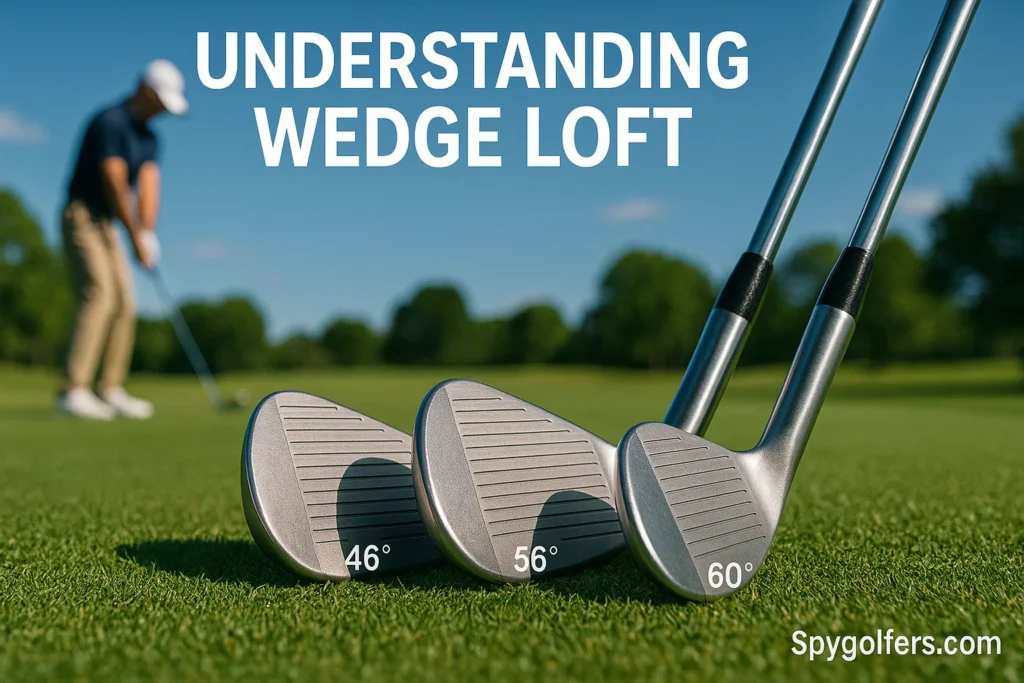Introduction
When it comes to improving your golf game, there’s one aspect that often gets overlooked by many golfers: wedge loft. While much attention is given to drivers, irons, and putters, wedges can be the true game-changer, particularly around the greens. Understanding the intricacies of wedge loft can help you gain more control over your short game, resulting in better scores and more consistent play. This guide will break down the importance of wedge loft, how to choose the right one, and how it impacts your shots on the course.
What Is Wedge Loft?
Wedge loft refers to the angle of the clubface in relation to the ground. This angle is crucial because it determines the trajectory, spin, and distance the ball will travel. The loft of a wedge affects how high or low the ball will fly and how much spin it will generate. Typically, wedges have lofts ranging from 44 degrees to 64 degrees, with different lofts tailored to various types of shots.
A wedge with a higher loft will produce a higher ball flight, which is useful for shots that need to clear an obstacle or stop quickly on the green. On the other hand, wedges with lower lofts tend to produce a lower flight and greater distance, which is ideal for longer approach shots.
For golfers, understanding wedge loft is essential for controlling your game, especially around the greens where precision and spin are paramount.
The Different Types of Wedges and Their Loft Angles
There are several types of wedges available in the golf world, each serving a unique purpose based on its loft. Let’s break down the most common types and their respective lofts:
1. Pitching Wedge (PW)
Loft Range: 44° – 48°
The pitching wedge is the most common wedge and is typically used for approach shots from 100 to 130 yards. It provides a relatively low loft compared to other wedges, allowing golfers to hit shots with a longer distance while still achieving enough trajectory to land softly on the green. A pitching wedge is ideal for situations where you need a solid, controlled shot to reach the green from a medium distance.
2. Gap Wedge (GW)
Loft Range: 48° – 52°
A gap wedge, also known as an approach wedge, fits between the pitching wedge and the sand wedge. It’s often used for shots from 85 to 115 yards, offering a bit more loft than the pitching wedge to help achieve more accuracy without sacrificing too much distance. A gap wedge is an essential club for players who want to fill the “gap” in their wedge lineup for better distance control in their short game.
3. Sand Wedge (SW)
Loft Range: 54° – 58°
The sand wedge is specifically designed for bunker shots and approach shots from 75 to 105 yards. Its higher loft allows golfers to get under the ball more easily, which is ideal for hitting from the sand or soft turf. The sand wedge also features a wider sole with a higher bounce angle, making it more forgiving when used in difficult lies.
4. Lob Wedge (LW)
Loft Range: 58° – 64°
The lob wedge is the highest-lofted wedge, ideal for short, high shots that need to stop quickly on the green. With lofts between 58° and 64°, it’s great for hitting over obstacles like trees or bunkers. A lob wedge provides exceptional control, allowing you to execute delicate chips and flops with precision. It’s an essential tool for players who need to clear high objects or make quick stops on fast greens.
Why Wedge Loft Matters in Your Short Game
The loft of your wedges significantly impacts several key elements of your short game. Understanding these effects can help you better manage your distances, trajectory, and spin, giving you more control over your shots.
1. Trajectory Control
The loft of a wedge determines how high or low the ball will fly. Higher lofts result in higher ball flights, which can help clear obstacles like bunkers or trees. Conversely, lower lofts produce a flatter ball flight, which is often necessary for longer approach shots.
For example, a lob wedge (with a high loft) is perfect for hitting a high shot over a sand trap, while a pitching wedge (with a lower loft) is better suited for a more controlled, lower approach shot.
2. Distance Control
Each wedge loft is designed to hit the ball a specific distance. The loft of a wedge determines how much air time the ball will have, as well as the total distance it will travel. By having a variety of wedges with different lofts, you can effectively control your distance on approach shots and around the green.
For instance, a pitching wedge might be used for shots around 100 yards, while a sand wedge might be used for shots between 75 to 100 yards. Understanding the exact yardages you can hit with each wedge helps you plan your shots more accurately.
3. Spin and Stopping Power
Wedge loft is directly related to the amount of spin a shot will generate. Higher lofted wedges tend to impart more spin on the ball, which is crucial for stopping the ball quickly on the green. This is especially important when you’re trying to get the ball to land softly and avoid rolling off the back of the green.
A lob wedge, for example, can create significant backspin, allowing the ball to stop quickly after landing. This makes it easier to execute delicate chips and approach shots that require high spin for control.
4. Versatility Around the Green
The different wedge lofts offer versatility when playing around the green. By having a variety of wedges in your bag, you can handle different lies, obstacles, and distances. For example, a lob wedge is useful for short, high shots, while a sand wedge can be used to get out of bunkers or play from soft grass.
How to Choose the Right Wedge Loft for Your Game
Choosing the right wedge loft for your game involves considering several factors. The correct wedge loft will depend on your skill level, swing characteristics, and the typical conditions of the courses you play.
1. Distance Gapping
A general rule of thumb is to have consistent distance gaps between each wedge in your bag. Most golfers use a pitching wedge, gap wedge, sand wedge, and lob wedge to cover a range of yardages. The loft differences between these clubs are usually between 4° to 6° to ensure proper distance gapping.
For example, if you hit your pitching wedge around 110 yards, your gap wedge should fill the gap by covering distances from 85 to 100 yards. This ensures you have a club for every shot within your short game range.
2. Course Conditions
The types of courses you play on can also influence your choice of wedge lofts. For instance, if you regularly play on courses with soft greens, you might prefer a wedge with a higher loft to generate more spin and stop the ball quickly. Alternatively, on firmer greens, a lower lofted wedge might help you achieve better roll-out.
3. Your Swing Characteristics
Your swing mechanics can influence the effectiveness of a wedge with a particular loft. Players with steeper swings may benefit from higher lofted wedges with more bounce, as these clubs prevent digging into the turf. Conversely, golfers with flatter swings might prefer wedges with less bounce to allow for cleaner contact.
4. Shot Variety
Consider the variety of shots you frequently encounter on the course. If you often need to clear obstacles like trees or bunkers, a lob wedge with a higher loft will be essential. If your primary challenge is distance control on approach shots, a gap or pitching wedge might suit you better.
The Importance of Bounce in Relation to Loft
Bounce refers to the angle between the leading edge of the clubface and the ground. It is crucial when it comes to how a wedge interacts with the turf, especially in soft conditions. Wedges with higher lofts tend to have more bounce, which helps prevent the club from digging into the ground, particularly in thick grass or sand.
For example, a sand wedge typically has a high bounce, making it perfect for getting under the ball in soft conditions like bunkers or thick rough. In contrast, a lob wedge with less bounce is better suited for firmer turf, allowing for cleaner contact and more control over delicate chips.
Understanding Bounce and Loft
Having the correct bounce for the type of course you play on and your swing type can drastically improve your wedge play. Players with steeper swings might want a wedge with more bounce to avoid digging, while golfers with shallow swings may benefit from less bounce for more precision on firmer ground.
How to Utilize Wedge Loft Effectively Around the Course
Once you have the correct wedges in your bag, it’s essential to know how and when to use them for optimal performance.
1. Pitching Wedge
Use the pitching wedge for approach shots from 100 to 130 yards, particularly when you need to cover a larger distance. It provides a good balance between distance and accuracy, making it the go-to club for mid-range shots.
2. Gap Wedge
The gap wedge is ideal for shots between 85 to 115 yards, providing the precision you need when you’re too close for a pitching wedge but too far for a sand wedge. This club helps fill the distance gap between your pitching wedge and sand wedge.
3. Sand Wedge
When you’re in a bunker or faced with a tricky lie in the sand, the sand wedge is the club you’ll want. With its higher loft and bounce, it allows for clean contact with the ball, lifting it easily from the sand or thick grass.
4. Lob Wedge
The lob wedge is designed for high, soft landing shots, especially when you need to get the ball up quickly and stop it on the green. Use this club for delicate chip shots, flop shots, or when you need to clear an obstacle.
Common Mistakes to Avoid with Wedge Loft
Even experienced golfers make common mistakes when it comes to wedge loft. Being aware of these mistakes can help you avoid errors that could negatively impact your short game.
1. Overlapping Yardages
One of the most common mistakes is having wedges with overlapping yardages. It’s essential to ensure that there’s a clear gap between each wedge in your bag, so you don’t find yourself stuck with no club to cover a particular distance.
2. Ignoring Bounce
Not considering the bounce angle of your wedges can lead to poor shot outcomes, particularly in soft conditions. If you use a low-bounce wedge on soft turf or sand, it can cause the club to dig, leading to poor shots.
3. Overreliance on the Lob Wedge
Using a lob wedge for every short game shot can limit your versatility. While lob wedges are excellent for high, soft shots, they may not always be the best choice for all types of short game shots.
4. Lack of Practice
Many golfers neglect to practice with their wedges, which results in poor shot execution when it matters most. Make sure you practice with each wedge to become familiar with how it performs in different situations.
Conclusion
Understanding wedge loft is essential for mastering the short game. By knowing the differences between the various types of wedges and their lofts, you can select the right club for every shot around the green. Whether you need to control spin, trajectory, or distance, each wedge plays a unique role in shaping your short game. By practicing with these wedges and selecting the appropriate loft for your swing and course conditions, you’ll improve your game and start lowering your scores. So next time you’re on the course, pay attention to your wedges, and you’ll be amazed at how much of a difference understanding wedge loft can make in your overall performance.


